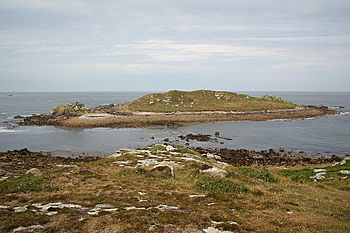Norrard Rocks facts for kids

Gweal viewed from Bryher
|
|
| Geography | |
|---|---|
| Coordinates | 49°57′12″N 6°22′12″W / 49.9533°N 6.3700°W |
| OS grid reference | SV867152 |
| Archipelago | Isles of Scilly |
| Administration | |
|
United Kingdom
|
|
| Civil parish | Bryher |
| Demographics | |
| Population | 0 |
The Norrard (Northern) Rocks are a group of small, rocky islands where no one lives. They are located in the north-western part of the Isles of Scilly, which is an archipelago off the coast of Cornwall, England. These rocks are found to the west of the islands of Bryher and Samson.
In 1971, the Norrard Rocks were given a special protected status. They became a Site of Special Scientific Interest (SSSI). This means they are important for their breeding seabird colonies. Because of this, you are not allowed to land on these islands from boats. Only a few types of flowering plants can grow here. This is because the islands are very exposed to strong winds and sea spray.
Contents
Why These Rocks Are Special: A Nature Reserve
The Norrard Rocks are mostly managed as nature reserves by the Isles of Scilly Wildlife Trust. Their main purpose is to protect seabirds that nest here and grey seals.
The European Storm-petrel is a small seabird. The only places in England where these birds breed are on the Isles of Scilly. There are eleven colonies in total, with about 1,475 pairs nesting. On the Norrard Rocks, there are three smaller breeding spots for them. These are on Mincarlo, Illiswilgig, and Castle Bryher, with a total of 37 pairs.
Other seabirds that breed in this special area include:
A special type of rove beetle called Omalium allardi has also been found on some of these islands.
Exploring the Norrard Rocks
Here are some of the individual islands and rocks that make up the Norrard Rocks group. They are listed from largest to smallest.
Gweal
Gweal (which means place of trees in Cornish) is about 5.82 hectares in size and 32 meters high.
Gweal is a small, rocky island made of two hills. These hills are connected by a beach covered in boulders. It is located just off the west coast of Bryher. Sometimes, grey seals use Gweal as a place to have their pups.
Some of the plants found here include:
- Sea beet
- Rock sea-spurry
- Common scurvygrass
- Thrift
- Tree mallow
Scilly Rock
Scilly Rock is about 1.98 hectares in size.
This large rock is located just over 1 kilometer west of Bryher. It is split into two parts by a deep gap, and its highest point is 22 meters. Each part has a summit named North Cuckoo and South Cuckoo. It is very hard to land on Scilly Rock, and you can only do it when the sea is calm. Some people believe this island is where the entire Isles of Scilly got its name, but there is no clear proof for this idea.
Puffins breed here. The only plants recorded on Scilly Rock are rock sea-spurrey and types of oraches.
Mincarlo
Mincarlo (meaning rayfish stone in Cornish) is about 1.82 hectares in size.
This is the southernmost island in the group, located 2 kilometers west of Samson. Many bird species nest on Mincarlo. It has the largest breeding colony of Cormorants in the Isles of Scilly. Other birds that nest here include:
During a survey in 2000, 17 nesting spots for the European Storm-petrel were counted here.
The island is also a main place where grey seals have their pups. Plants like tree mallow, orache, common scurvygrass, rock sea-spurrey, and sea beet have been found on Mincarlo.
Illiswilgig
Illiswilgig (meaning grassy island in Cornish) is about 0.90 hectares in size.
Several bird species have bred on Illiswilgig. A small colony of only three pairs of European Storm-petrels was recorded here during a survey in 2000.
Plants found on Illiswilgig include:
- Tree mallow
- Thrift
- Sea beet
- Rock sea-spurrey
- Common scurvygrass
- Orache
- English stonecrop
Illiswilgig is an important place for grey seals to have their pups and to rest on the rocks.
Maiden Bower
Maiden Bower (meaning great stones in Cornish) is about 0.66 hectares in size.
Only a few gulls breed on Maiden Bower. No plants have been recorded growing on this island.
Castle Bryher
Castle Bryher (meaning Bryher's castle in Cornish) is about 0.39 hectares in size and 26 meters high.
A survey in 2000 counted 17 nesting spots for the European Storm-petrel on Castle Bryher. Puffins and gulls also breed on this island.
Plants found here include:
- Tree mallow
- Sea beet
- Rock sea-spurrey
- Common scurvygrass
- Orache
Seal Rock
Seal Rock is about 0.20 hectares in size.
This rock is a very important place for grey seals. They use it for breeding and as a place to rest out of the water. The only plant recorded on Seal Rock is orache.


